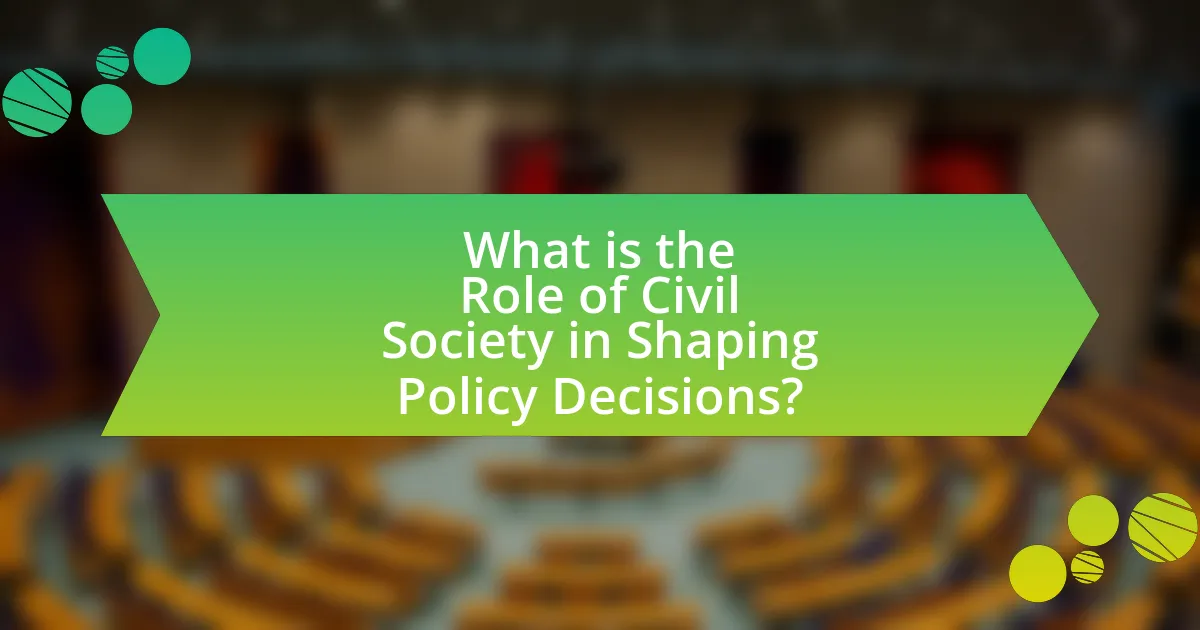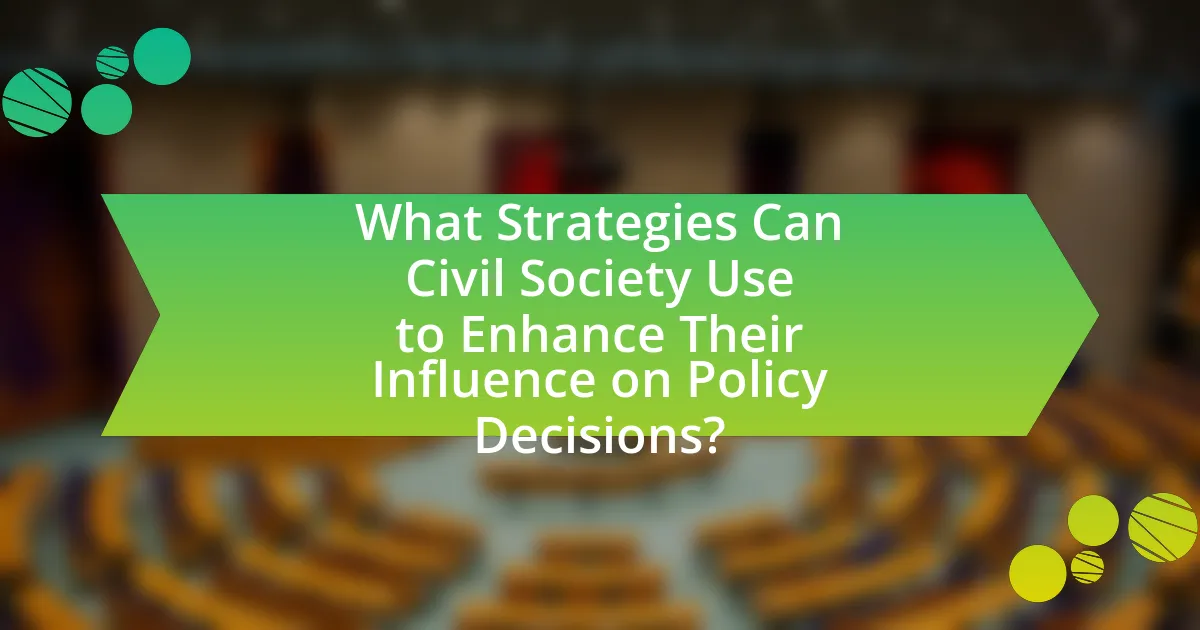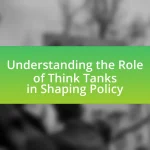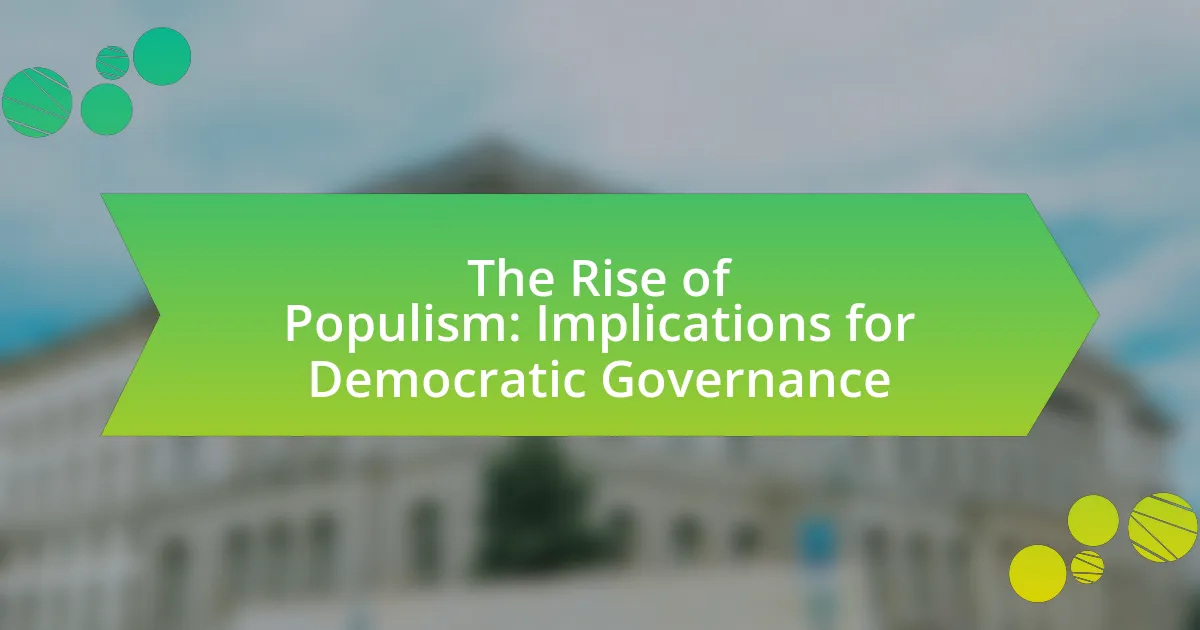Civil society plays a vital role in shaping policy decisions by advocating for diverse interests, influencing public opinion, and ensuring government accountability. This article examines how civil society organizations, including NGOs and grassroots movements, impact policy-making processes through advocacy, public mobilization, and participation. It highlights the mechanisms of influence, the importance of civil society in democratic governance, and the challenges faced in advocacy efforts. Additionally, the article explores the various types of civil society organizations, their strategies for enhancing influence, and the significance of public awareness and technology in advocacy campaigns.

What is the Role of Civil Society in Shaping Policy Decisions?
Civil society plays a crucial role in shaping policy decisions by advocating for the interests and rights of various groups, influencing public opinion, and holding governments accountable. Organizations within civil society, such as non-governmental organizations (NGOs), community groups, and advocacy networks, engage in activities like lobbying, public campaigns, and research to inform policymakers. For instance, studies have shown that civil society organizations can significantly impact environmental policy by mobilizing public support and providing expert knowledge, as evidenced by the success of grassroots movements in promoting climate action. This engagement not only enhances democratic governance but also ensures that diverse voices are represented in the policymaking process.
How does civil society influence policy-making processes?
Civil society influences policy-making processes by advocating for specific issues, mobilizing public opinion, and holding governments accountable. Organizations within civil society, such as non-governmental organizations (NGOs) and community groups, engage in lobbying efforts to present their perspectives to policymakers. For instance, studies show that civil society organizations can significantly impact environmental policy by raising awareness and pushing for legislative changes, as seen in the 2015 Paris Agreement negotiations where various NGOs played a crucial role in shaping climate policies. Additionally, civil society acts as a watchdog, ensuring transparency and accountability in government actions, which can lead to more responsive and inclusive policy-making.
What are the key mechanisms through which civil society exerts influence?
Civil society exerts influence primarily through advocacy, public mobilization, and participation in policy-making processes. Advocacy involves organized efforts to promote specific issues or interests, often leading to policy changes; for instance, environmental NGOs have successfully lobbied for stricter regulations on pollution. Public mobilization engages citizens in campaigns, raising awareness and pressure on decision-makers, as seen in movements like Black Lives Matter, which have significantly impacted public discourse and policy. Participation in policy-making includes civil society organizations contributing to consultations, drafting legislation, and providing expert testimony, which enhances democratic governance and accountability. These mechanisms collectively empower civil society to shape policies effectively.
How do advocacy and lobbying differ in their impact on policy decisions?
Advocacy and lobbying differ in their impact on policy decisions primarily in their approach and scope. Advocacy encompasses broader efforts to influence public opinion and raise awareness about specific issues, aiming for systemic change, while lobbying focuses on direct interaction with policymakers to influence specific legislation or regulations. For instance, advocacy campaigns may mobilize grassroots support and utilize media to shape societal views, as seen in movements like climate change awareness, which have led to significant policy shifts over time. In contrast, lobbying often involves professional lobbyists who engage in targeted discussions with legislators, as evidenced by the substantial financial investments made by organizations in lobbying efforts, which totaled approximately $3.5 billion in the United States in 2020. This distinction highlights that while advocacy seeks to create a conducive environment for policy change, lobbying aims for immediate legislative outcomes.
Why is civil society important in democratic governance?
Civil society is crucial in democratic governance because it fosters citizen participation, accountability, and advocacy for rights. By providing a platform for diverse voices, civil society organizations enable individuals to engage in political processes, influencing policy decisions and holding governments accountable. For instance, studies show that countries with active civil societies tend to have higher levels of political participation and transparency, as evidenced by the Global Civil Society Index, which correlates robust civil engagement with improved governance outcomes.
What functions does civil society serve in a democracy?
Civil society serves multiple essential functions in a democracy, including promoting civic engagement, advocating for social justice, and holding government accountable. These functions enable citizens to participate actively in the political process, ensuring that diverse voices are heard and considered in policy-making. For instance, organizations within civil society often mobilize public opinion and influence legislation by raising awareness about critical issues, as seen in movements like the Civil Rights Movement in the United States, which significantly impacted policy changes. Additionally, civil society acts as a watchdog, monitoring government actions and promoting transparency, which is crucial for preventing corruption and abuse of power.
How does civil society contribute to accountability and transparency?
Civil society contributes to accountability and transparency by acting as a watchdog that monitors government actions and policies. Organizations within civil society, such as non-governmental organizations (NGOs) and advocacy groups, engage in activities like reporting on government performance, mobilizing public opinion, and providing platforms for citizen participation. For instance, the Global Accountability Project highlights how civil society organizations have successfully exposed corruption and mismanagement in various countries, leading to policy reforms and increased governmental oversight. This monitoring role ensures that public officials are held accountable for their actions, thereby fostering a culture of transparency and trust in governance.
What challenges does civil society face in influencing policy?
Civil society faces significant challenges in influencing policy, primarily due to limited access to decision-makers and resources. These organizations often struggle to engage effectively with government officials, who may prioritize other interests or lack awareness of civil society’s perspectives. Additionally, civil society groups frequently encounter financial constraints, which hinder their ability to conduct research, mobilize support, and sustain advocacy efforts. According to a report by the World Bank, over 70% of civil society organizations cite funding as a critical barrier to their effectiveness in policy influence. Furthermore, political repression in various regions can stifle civil society’s voice, as governments may impose restrictions on freedom of assembly and expression, further complicating their efforts to advocate for policy changes.
What are the common obstacles to effective advocacy?
Common obstacles to effective advocacy include lack of resources, insufficient public awareness, and political resistance. Limited funding and manpower hinder organizations from reaching their target audiences and implementing campaigns effectively. Additionally, when the public is unaware of specific issues, advocacy efforts struggle to gain traction, as seen in various social movements where awareness campaigns were crucial for mobilization. Political resistance often arises from entrenched interests that oppose change, making it difficult for advocates to influence policy decisions. These factors collectively impede the ability of civil society to shape policy effectively.
How do political environments affect civil society’s role?
Political environments significantly influence civil society’s role by determining the level of freedom and resources available for civic engagement. In democratic settings, civil society organizations often thrive, as they can advocate for policy changes, mobilize citizens, and hold governments accountable. For instance, in countries like Sweden and Canada, robust civil societies contribute to participatory governance and social welfare policies. Conversely, in authoritarian regimes, civil society faces repression, limiting its ability to operate effectively. In countries such as Belarus and North Korea, restrictive laws and state control hinder civic participation, resulting in diminished advocacy for public interests. Thus, the political context directly shapes the capacity and effectiveness of civil society in influencing policy decisions.

How do Different Types of Civil Society Organizations Impact Policy Decisions?
Different types of civil society organizations (CSOs) impact policy decisions by influencing public opinion, advocating for specific issues, and holding governments accountable. For instance, advocacy groups like environmental organizations can sway policy by mobilizing public support and presenting scientific evidence, which was evident in the 2015 Paris Agreement negotiations where NGOs played a crucial role in raising awareness about climate change. Additionally, grassroots organizations often engage communities directly, fostering local participation in policy-making processes, as seen in various community-led initiatives that have successfully lobbied for changes in local governance. Research indicates that CSOs contribute to more transparent and participatory governance, thereby enhancing the quality of policy decisions.
What are the various types of civil society organizations?
Civil society organizations (CSOs) can be categorized into several types, including non-governmental organizations (NGOs), community-based organizations (CBOs), advocacy groups, professional associations, and faith-based organizations. NGOs focus on specific issues such as human rights, environmental protection, or health, while CBOs are grassroots organizations that serve local communities. Advocacy groups aim to influence public policy and raise awareness on particular issues. Professional associations represent the interests of specific professions, and faith-based organizations integrate religious values into their missions. These classifications highlight the diverse roles CSOs play in shaping policy decisions and addressing societal needs.
How do non-governmental organizations (NGOs) differ from grassroots movements?
Non-governmental organizations (NGOs) are formal entities that operate independently of government influence, often with structured funding and specific missions, while grassroots movements are informal, community-driven initiatives that arise organically to address local issues. NGOs typically have established frameworks, professional staff, and resources to implement programs, whereas grassroots movements rely on volunteer efforts and community engagement to mobilize support and effect change. For example, NGOs like Amnesty International focus on global human rights advocacy with a structured approach, while grassroots movements such as the Black Lives Matter movement emerge from community activism to address systemic racism and police violence. This distinction highlights the varying levels of organization, funding, and operational strategies between the two types of civil society actors.
What role do think tanks play in shaping public policy?
Think tanks play a crucial role in shaping public policy by conducting research, providing expert analysis, and offering policy recommendations to government officials and the public. They influence policy debates through the dissemination of their findings, which often include data-driven insights and innovative solutions to complex issues. For instance, a study by the Brookings Institution found that think tanks significantly impact legislative outcomes by supplying lawmakers with evidence-based information that informs their decisions. This demonstrates that think tanks not only contribute to the knowledge base surrounding policy issues but also actively engage in the policymaking process, thereby shaping the direction of public policy.
How do international civil society organizations influence local policy?
International civil society organizations influence local policy primarily through advocacy, capacity building, and providing resources. These organizations engage in lobbying efforts to shape public opinion and policy agendas, often leveraging their global networks to amplify local voices. For instance, organizations like Amnesty International and Human Rights Watch have successfully pressured governments to adopt human rights protections by mobilizing international attention and support. Additionally, they often provide training and resources to local groups, enhancing their ability to engage with policymakers effectively. Research indicates that such organizations can significantly impact local governance by fostering accountability and transparency, as seen in various case studies across different countries.
What strategies do international organizations use to engage with local issues?
International organizations engage with local issues through strategies such as partnership building, capacity development, and participatory approaches. These strategies enable organizations to collaborate with local stakeholders, enhance local capacities, and ensure that community voices are integrated into decision-making processes. For instance, the United Nations Development Programme (UNDP) often partners with local NGOs to implement development projects, ensuring that local needs and perspectives are prioritized. Additionally, international organizations may conduct workshops and training sessions to empower local communities, fostering sustainable development and resilience. This approach is supported by evidence showing that inclusive participation leads to more effective and contextually relevant policy outcomes.
How can local civil society benefit from international partnerships?
Local civil society can benefit from international partnerships by gaining access to resources, knowledge, and networks that enhance their capacity to influence policy decisions. These partnerships often provide funding, technical assistance, and training, which empower local organizations to implement effective programs and advocate for their communities. For instance, a study by the World Bank indicates that civil society organizations engaged in international collaborations are more likely to achieve sustainable development goals due to improved skills and increased visibility. Additionally, international partnerships can facilitate the sharing of best practices and innovative approaches, enabling local civil society to adopt successful strategies from other contexts, thereby strengthening their overall impact on policy shaping.

What Strategies Can Civil Society Use to Enhance Their Influence on Policy Decisions?
Civil society can enhance its influence on policy decisions through advocacy, coalition-building, and public engagement. Advocacy involves actively promoting specific policy changes by mobilizing public support and leveraging media platforms to raise awareness about issues. Coalition-building allows civil society organizations to unite diverse groups, amplifying their collective voice and increasing their negotiating power with policymakers. Public engagement, including grassroots campaigns and participatory forums, fosters dialogue between citizens and decision-makers, ensuring that community needs and perspectives are considered in policy formulation. These strategies have been effective in various contexts, such as the successful mobilization of civil society in the 2011 Arab Spring, which demonstrated the power of organized advocacy and public engagement in influencing government policies.
What are effective advocacy strategies for civil society organizations?
Effective advocacy strategies for civil society organizations include grassroots mobilization, coalition building, and strategic communication. Grassroots mobilization empowers communities to engage in advocacy efforts, as seen in the successful campaigns for environmental protection, where local communities organized to influence policy changes. Coalition building enhances the impact of advocacy by uniting diverse organizations around common goals, exemplified by the Global Climate Strike, which brought together various groups to demand climate action. Strategic communication involves crafting clear, compelling messages that resonate with target audiences, supported by data and personal stories, as demonstrated by organizations like Amnesty International, which effectively uses storytelling to highlight human rights issues.
How can coalition-building strengthen advocacy efforts?
Coalition-building strengthens advocacy efforts by uniting diverse stakeholders to amplify their collective voice and influence. When organizations collaborate, they can pool resources, share expertise, and create a more comprehensive approach to addressing issues, which enhances their credibility and reach. For example, the formation of coalitions like the Climate Action Network has demonstrated that coordinated efforts can lead to significant policy changes, such as the Paris Agreement, where multiple organizations worked together to advocate for global climate action. This collaborative strategy not only increases visibility but also fosters a sense of solidarity among members, making advocacy campaigns more effective and impactful.
What role does public awareness play in influencing policy change?
Public awareness plays a crucial role in influencing policy change by mobilizing public opinion and creating pressure on policymakers. When citizens are informed about specific issues, they are more likely to advocate for change, which can lead to increased political engagement and activism. For instance, the rise of social media has amplified public awareness campaigns, as seen in movements like Black Lives Matter, which have successfully influenced legislative reforms on police practices. Research indicates that heightened public awareness can lead to significant shifts in policy, as demonstrated by the 2015 Paris Agreement on climate change, where widespread public concern about global warming prompted governments to commit to reducing carbon emissions.
How can civil society leverage technology in policy advocacy?
Civil society can leverage technology in policy advocacy by utilizing digital platforms for mobilization, communication, and data analysis. These platforms enable organizations to reach wider audiences, engage stakeholders, and disseminate information rapidly. For instance, social media campaigns can amplify voices and raise awareness on critical issues, as seen in movements like #MeToo, which effectively influenced public policy discussions. Additionally, data analytics tools allow civil society organizations to gather and analyze public opinion, providing evidence-based insights that can strengthen their advocacy efforts. According to a report by the World Economic Forum, 70% of civil society organizations reported increased effectiveness in advocacy through the use of technology, demonstrating its significant impact on shaping policy decisions.
What digital tools are most effective for mobilizing support?
Social media platforms, email campaigns, and crowdfunding websites are the most effective digital tools for mobilizing support. Social media platforms like Facebook and Twitter enable rapid dissemination of information and engagement with large audiences, facilitating grassroots movements. Email campaigns allow organizations to communicate directly with supporters, providing updates and calls to action that can lead to increased participation. Crowdfunding websites, such as GoFundMe and Kickstarter, enable individuals and groups to raise funds for specific causes, demonstrating community backing and financial support. These tools have been shown to significantly enhance mobilization efforts, as evidenced by the success of campaigns like the Ice Bucket Challenge, which raised over $115 million for ALS research through social media engagement.
How can social media campaigns impact public policy discussions?
Social media campaigns can significantly influence public policy discussions by amplifying citizen voices and mobilizing grassroots movements. These campaigns facilitate rapid information dissemination, allowing individuals and organizations to share their perspectives and advocate for specific policy changes. For instance, the #MeToo movement utilized social media to raise awareness about sexual harassment, leading to legislative changes in various jurisdictions. Research indicates that social media can increase public engagement and pressure policymakers to respond to constituents’ concerns, as seen in the 2018 March for Our Lives campaign advocating for gun control, which garnered widespread support and media attention.
What best practices should civil society organizations follow to maximize their impact?
Civil society organizations should adopt a strategic approach that includes clear objectives, stakeholder engagement, and evidence-based advocacy to maximize their impact. Establishing specific, measurable goals allows organizations to focus their efforts and assess progress effectively. Engaging stakeholders, including community members and policymakers, fosters collaboration and ensures that initiatives are relevant and supported. Utilizing data and research to inform advocacy efforts enhances credibility and effectiveness, as evidenced by studies showing that data-driven campaigns can increase policy influence by up to 50%. These practices collectively strengthen the capacity of civil society organizations to shape policy decisions effectively.
How can organizations measure their influence on policy outcomes?
Organizations can measure their influence on policy outcomes through various methods, including tracking changes in legislation, analyzing media coverage, and conducting surveys of policymakers. By monitoring legislative changes, organizations can assess whether their advocacy efforts have led to the adoption or modification of specific policies. For instance, a study by the Center for American Progress found that targeted lobbying efforts resulted in significant shifts in healthcare policy, demonstrating a direct correlation between advocacy and legislative outcomes. Additionally, analyzing media coverage can provide insights into public perception and the framing of issues, which can reflect the effectiveness of an organization’s messaging. Surveys of policymakers can also reveal how much influence organizations believe they have had on decision-making processes. These methods collectively provide a comprehensive framework for organizations to evaluate their impact on policy outcomes.
What are the key elements of a successful advocacy campaign?
The key elements of a successful advocacy campaign include a clear goal, a well-defined target audience, effective messaging, strategic partnerships, and a robust action plan. A clear goal provides direction and focus, ensuring that all efforts are aligned towards a specific outcome. Identifying a well-defined target audience allows advocates to tailor their messages and strategies to resonate with those who have the power to influence change. Effective messaging is crucial; it must be compelling and easily understood to mobilize support and raise awareness. Strategic partnerships enhance credibility and expand reach, as collaboration with like-minded organizations can amplify the campaign’s impact. Finally, a robust action plan outlines the steps needed to achieve the campaign’s objectives, including timelines, resources, and evaluation metrics to measure success. These elements collectively contribute to the effectiveness of advocacy efforts in shaping policy decisions.






